Abstract
Abdominal aortic aneurysmectomy (AAA) results in thromboxane (Tx)A2 generation, a rise in mean pulmonary artery pressure (MPAP), leukopenia, and noncardiogenic pulmonary edema. This study tests whether mannitol, a hydroxyl radical scavenger, modifies these events. Patients received mannitol 0.2 g/kg (n = 14) or saline (n = 12) intravenously before infrarenal aortic clamping. With saline, 30 minutes after clamping, plasma TxB2 levels rose from 124 to 290 pg/mL (p less than 0.01), and MPAP rose from 19 to 27 mmHg (p less than 0.01). Aortic clamp release led to further increases in plasma TxB2 to 378 pg/mL (p less than 0.01) and MPAP to 34 mmHg (p less than 0.01). The white blood count (WBC) fell from 9800 to 4400/mm3 (p less than 0.01). Four to eight hours after surgery, physiologic shunting (Q[sc]S[xsc]/Q[sc]T[xsc]) rose from 9% to 20% (p less than 0.01) and peak inspiratory pressure (PIP) increased from 22 to 32 cmH2O (p less than 0.01). Chest radiography demonstrated pulmonary edema while the pulmonary wedge pressure was 12 mmHg, excluding left ventricular failure. By 24 hours pulmonary edema resolved and the PIP and PaO2 returned to baseline. Mannitol treatment relative to saline, during and after aortic clamping reduced plasma TxB2 levels to 155 and 198 pg/mL, respectively (p less than 0.01); MPAP to 21 and 26 mmHg (p less than 0.01); minimized the decline in WBC to 5850/mm3 (p less than 0.01), and the postoperative rise in Q[sc]S[xsc]/Q[sc]T[xsc] to 12%, and PIP to 28 cmH2O (both p less than 0.01). Chest radiography showed no pulmonary edema. Finally in vitro studies documented that mannitol 1 to 10(-4)M, but not dextrose, in a dose-dependent manner inhibited Tx synthesis by ADP-activated platelets. These data indicate that mannitol maintains pulmonary function after AAA by limiting ischemia-induced thromboxane synthesis.
Full text
PDF
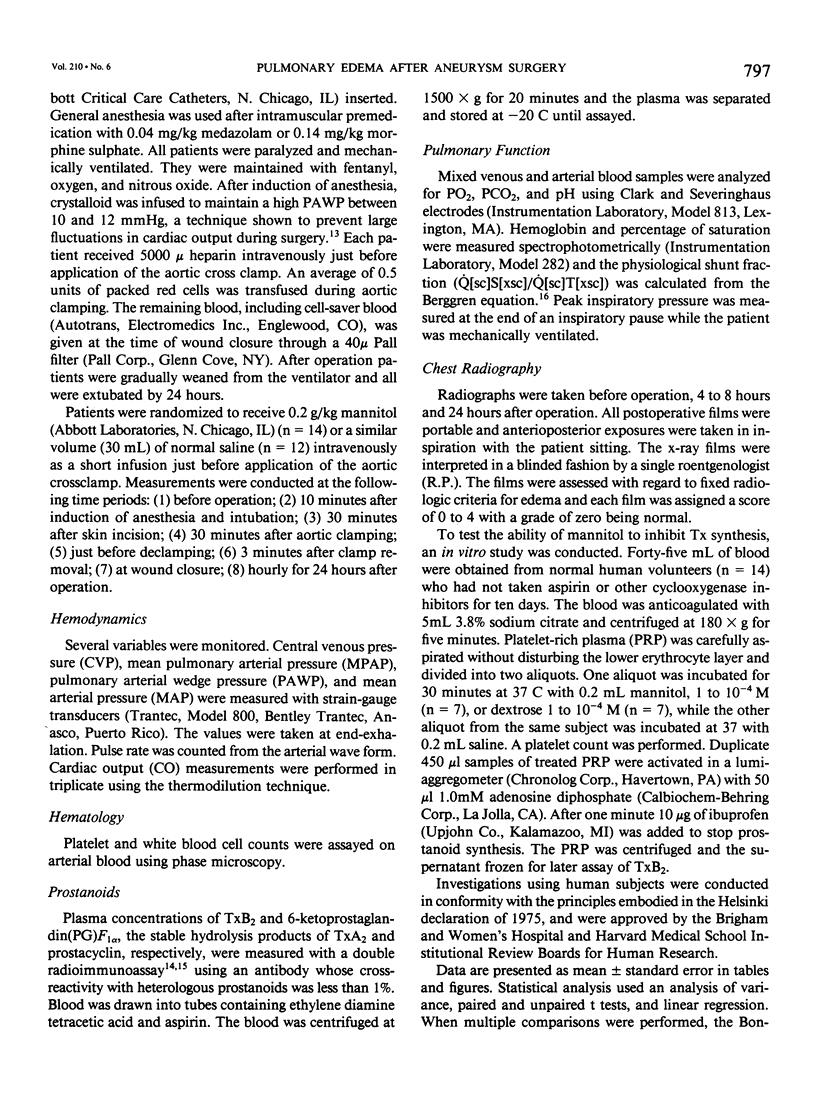
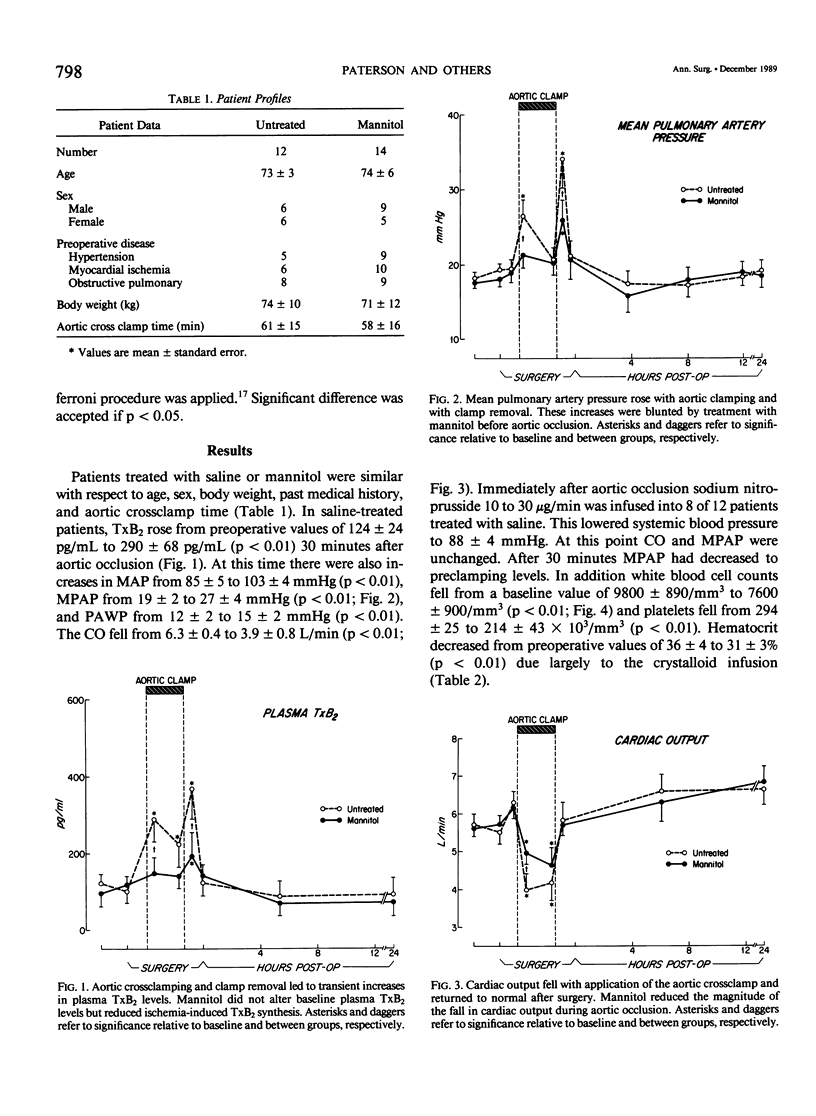
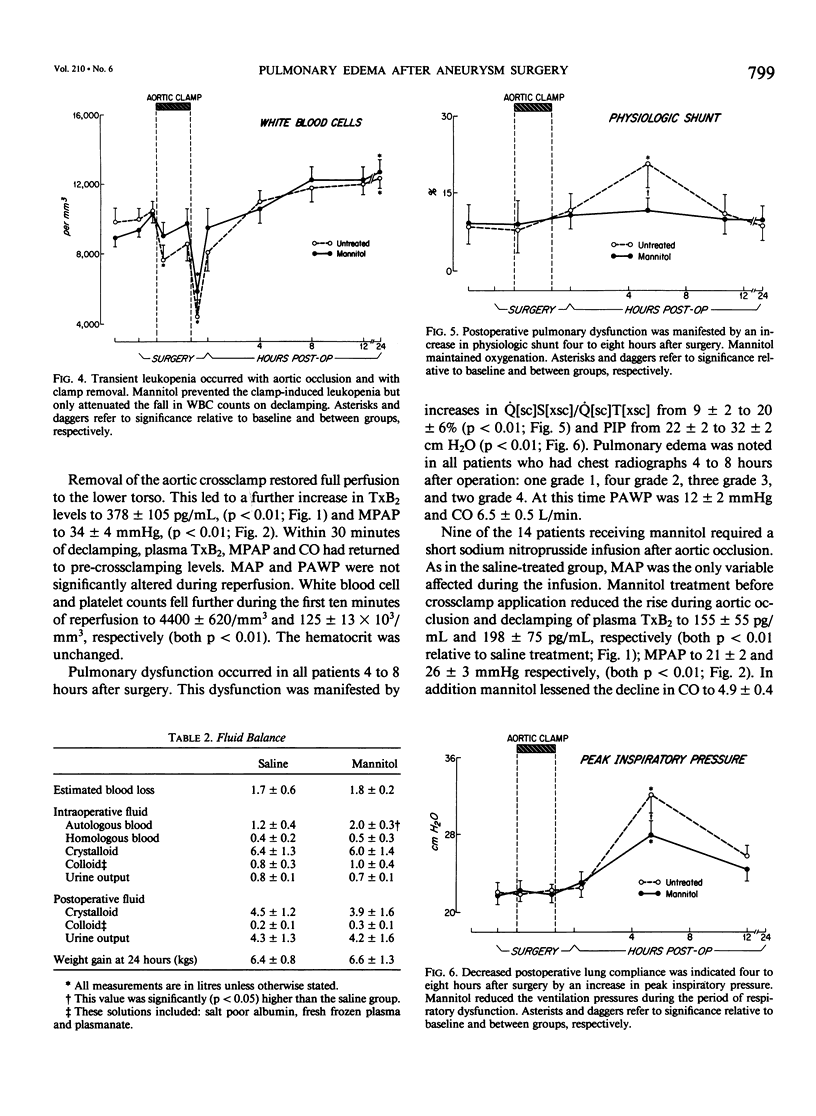
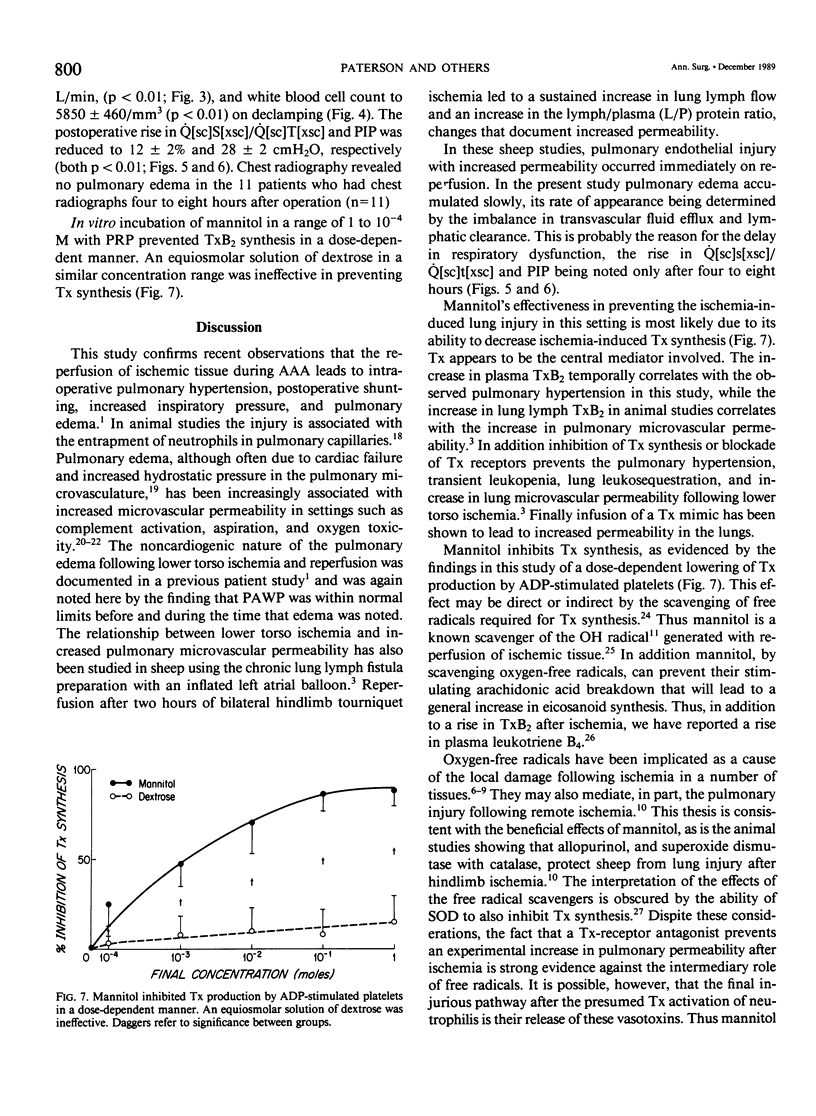
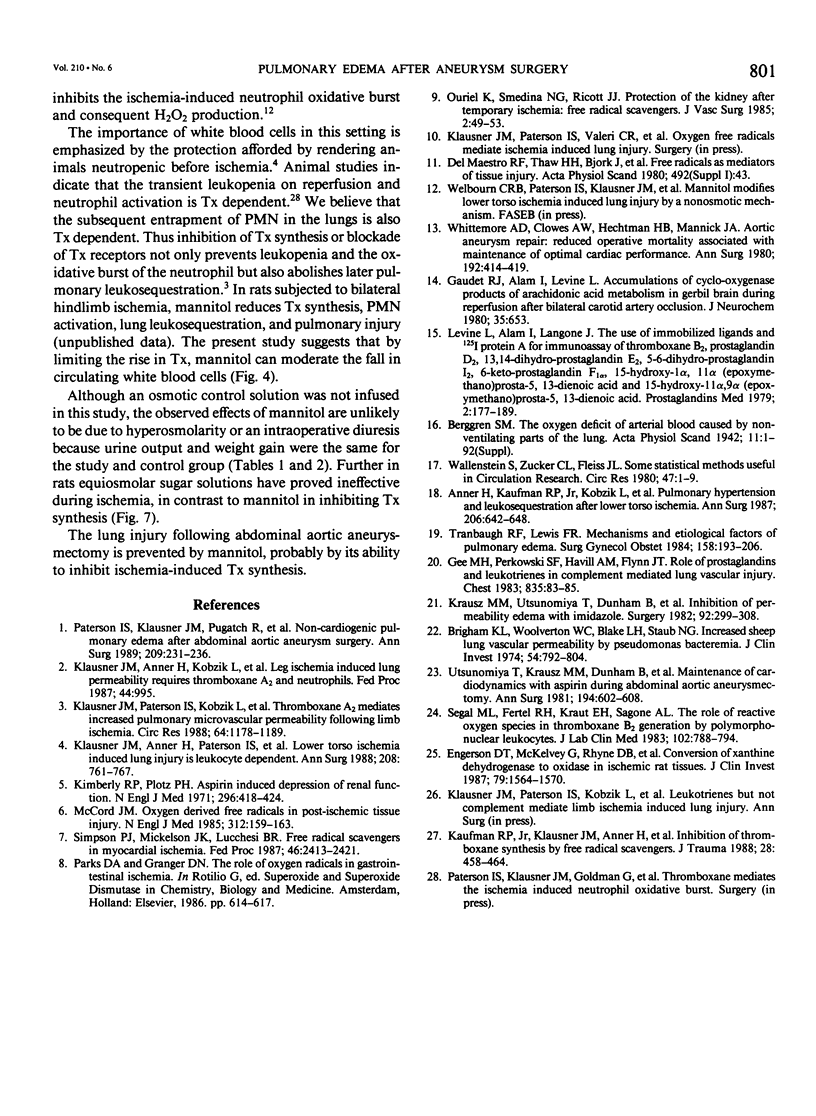
Selected References
These references are in PubMed. This may not be the complete list of references from this article.
- Anner H., Kaufman R. P., Jr, Kobzik L., Valeri C. R., Shepro D., Hechtman H. B. Pulmonary hypertension and leukosequestration after lower torso ischemia. Ann Surg. 1987 Nov;206(5):642–648. doi: 10.1097/00000658-198711000-00015. [DOI] [PMC free article] [PubMed] [Google Scholar]
- Brigham K. L., Woolverton W. C., Blake L. H., Staub N. C. Increased sheep lung vascular permeability caused by pseudomonas bacteremia. J Clin Invest. 1974 Oct;54(4):792–804. doi: 10.1172/JCI107819. [DOI] [PMC free article] [PubMed] [Google Scholar]
- Engerson T. D., McKelvey T. G., Rhyne D. B., Boggio E. B., Snyder S. J., Jones H. P. Conversion of xanthine dehydrogenase to oxidase in ischemic rat tissues. J Clin Invest. 1987 Jun;79(6):1564–1570. doi: 10.1172/JCI112990. [DOI] [PMC free article] [PubMed] [Google Scholar]
- Gaudet R. J., Alam I., Levine L. Accumulation of cyclooxygenase products of arachidonic acid metabolism in gerbil brain during reperfusion after bilateral common carotid artery occlusion. J Neurochem. 1980 Sep;35(3):653–658. doi: 10.1111/j.1471-4159.1980.tb03704.x. [DOI] [PubMed] [Google Scholar]
- Kaufman R. P., Jr, Klausner J. M., Anner H., Feingold H., Kobzik L., Valeri C. R., Shepro D., Hechtman H. B. Inhibition of thromboxane (Tx) synthesis by free radical scavengers. J Trauma. 1988 Apr;28(4):458–464. doi: 10.1097/00005373-198804000-00007. [DOI] [PubMed] [Google Scholar]
- Kimberly R. P., Plotz P. H. Aspirin-induced depression of renal function. N Engl J Med. 1977 Feb 24;296(8):418–424. doi: 10.1056/NEJM197702242960803. [DOI] [PubMed] [Google Scholar]
- Klausner J. M., Anner H., Paterson I. S., Kobzik L., Valeri C. R., Shepro D., Hechtman H. B. Lower torso ischemia-induced lung injury is leukocyte dependent. Ann Surg. 1988 Dec;208(6):761–767. doi: 10.1097/00000658-198812000-00015. [DOI] [PMC free article] [PubMed] [Google Scholar]
- Klausner J. M., Paterson I. S., Goldman G., Kobzik L., Valeri C. R., Shepro D., Hechtman H. B. Thromboxane A2 mediates increased pulmonary microvascular permeability following limb ischemia. Circ Res. 1989 Jun;64(6):1178–1189. doi: 10.1161/01.res.64.6.1178. [DOI] [PubMed] [Google Scholar]
- Krausz M. M., Utsunomiya T., Dunham B., Valeri C. R., Shepro D., Hechtman H. B. Inhibition of permeability edema with imidazole. Surgery. 1982 Aug;92(2):299–308. [PubMed] [Google Scholar]
- Levine L., Alam I., Langone J. J. The use of immobilized ligands and [125I]protein a for immunoassays of thromboxane B2, prostaglandin D2, 13,14-dihydro-prostaglandin E2, 5,6-dihydro-prostaglandin I2, 6-keto-prostaglandin F1 alpha, 15-hydroxy-9 alpha, 11 alpha(epoxymethano)prosta-5,13-dienoic acid and 15-hydroxy-11 alpha,9 alpha(epoxymethano)prosta-5,13-dienoic acid. Prostaglandins Med. 1979 Mar;2(3):177–189. doi: 10.1016/0161-4630(79)90035-1. [DOI] [PubMed] [Google Scholar]
- McCord J. M. Oxygen-derived free radicals in postischemic tissue injury. N Engl J Med. 1985 Jan 17;312(3):159–163. doi: 10.1056/NEJM198501173120305. [DOI] [PubMed] [Google Scholar]
- Ouriel K., Smedira N. G., Ricotta J. J. Protection of the kidney after temporary ischemia: free radical scavengers. J Vasc Surg. 1985 Jan;2(1):49–53. [PubMed] [Google Scholar]
- Paterson I. S., Klausner J. M., Pugatch R., Allen P., Mannick J. A., Shepro D., Hechtman H. B. Noncardiogenic pulmonary edema after abdominal aortic aneurysm surgery. Ann Surg. 1989 Feb;209(2):231–236. doi: 10.1097/00000658-198902000-00015. [DOI] [PMC free article] [PubMed] [Google Scholar]
- Segal M. L., Fertel R. H., Kraut E. H., Sagone A. L. The role of reactive oxygen species in thromboxane b2 generation by polymorphonuclear leukocytes. J Lab Clin Med. 1983 Nov;102(5):788–794. [PubMed] [Google Scholar]
- Simpson P. J., Mickelson J. K., Lucchesi B. R. Free radical scavengers in myocardial ischemia. Fed Proc. 1987 May 15;46(7):2413–2421. [PubMed] [Google Scholar]
- Tranbaugh R. F., Lewis F. R. Mechanisms and etiologic factors of pulmonary edema. Surg Gynecol Obstet. 1984 Feb;158(2):193–206. [PubMed] [Google Scholar]
- Utsunomiya T., Krausz M. M., Dunham B., Mannick J. A., Allen P. D., Shepro D., Hechtman H. B. Maintenance of cardiodynamics with aspirin during abdominal aortic aneurysmectomy (AAA). Ann Surg. 1981 Nov;194(5):602–608. doi: 10.1097/00000658-198111000-00008. [DOI] [PMC free article] [PubMed] [Google Scholar]
- Wallenstein S., Zucker C. L., Fleiss J. L. Some statistical methods useful in circulation research. Circ Res. 1980 Jul;47(1):1–9. doi: 10.1161/01.res.47.1.1. [DOI] [PubMed] [Google Scholar]
- Whittemore A. D., Clowes A. W., Hechtman H. B., Mannick J. A. Aortic aneurysm repair. Reduced operative mortality associated with maintenance of optimal cardiac performance. Ann Surg. 1980 Sep;192(3):414–421. doi: 10.1097/00000658-198009000-00017. [DOI] [PMC free article] [PubMed] [Google Scholar]


